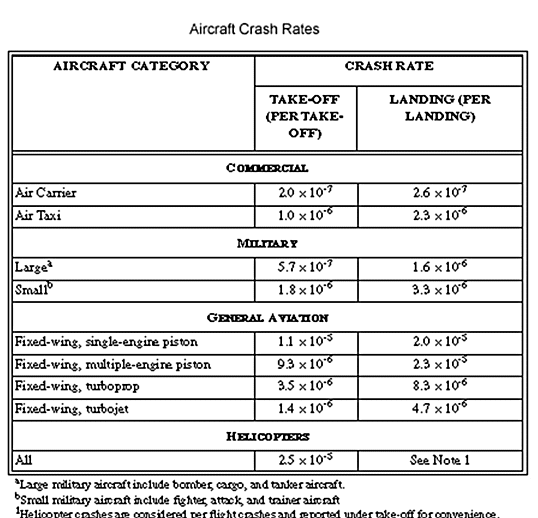







All aircraft are built with the same basic elements: wings to provide lift, engine(s) to provide motive power, a fuselage to carry the payload and controls, and a tail assembly which usually controls the direction of flight. These elements differ in shape, size, number, and position. The differences distinguish one aircraft type from another.






Aircraft Components
Angle of Attack (AOA) The angle between the wing and the relative wind. When all else is held constant, an increase in AOA results in an increase in lift. This increase continues until the stall AOA is reached then the trend reverses itself and an increase in AOA results in decreased lift.
Ailerons -- Located on the outer part of the wing, the ailerons help the airplane turn. Ailerons are control surfaces which are used to change the bank of the airplane, or roll the airplane. As the ailerons hinge down on one wing, they push the air downwards, making that wing tilt up. This tips the airplane to the side and helps it turn. This tipping is known as Banking. They are manipulated from the cockpit by moving the control column (stick) left and right. Right movement rolls the airplane to the right and vice versa. Roll speed is proportional to the amount of stick deflection. Once a desired bank is attained, the stick is centered to maintain the bank. Airfoil Section -- is the cross-sectional shape of the wing. The airfoil section shape and placement on the fuselage are directly linked to the airplanes performance.

Angle of Attack.
Bank -- The angle between the wings and the horizon, as viewed from the rear of the airplane. An airplane with its wings level has zero degrees of bank.
Banking -- Pushing the control stick in the cockpit to the left or right makes the ailerons on one wing go down and the ailerons on the other wing go up. This makes the plane tip to the left or right. This is called Banking. Banking makes the plane turn. Like a bicycle, the plane tilts, or banks, as it turns. This process is also called Roll. Cockpit -- Where the pilot sits. All of the controls and instruments are located here. Control Stick -- The ailerons are connected to the Control Stick which is located in cockpit. Pushing the stick to the left or to the right makes the ailerons on one wing go down and the ailerons on the other wing go up. This makes the plane tip to the left or right. This is called banking. This tipping is also called roll. Drag -- One of the four basic principles of flight. Drag is the force encountered as an airplane pushes through the air, which tends to slow the airplane down. There are two types of drag, and an airplane must fight its way through both kinds of drag in order to maintain steady flight.

Bank Angle
Elevators -- The Elevators are movable flaps attached to the horizontal stabilizer used to change the angle of AOA of the wing which will, in turn, change the pitch, moving the airplane up and down. It is operated by moving the control stick forward or backward, which in turn moves the elevator down or up, respectively. When the pilot "moves the stick forward to make the trees bigger and back to make them smaller", it is the elevator that does the work. Engine -- This part of the plane produces thrust or forward movement necessary to sustain flight. Thrust is one of the four basic rules behind plane flight. The engine turns the propeller. Flaps -- Located on the inner part of the wing, the Flaps help the plane fly slower. This helps to increase the lifting force of the wing at slower speeds, like during takeoff and landing. These slower speeds make takeoff and landing distances shorter. The Flaps slide back and forth, and are controlled by a lever in the cockpit. Flaps are moved down from a streamlined position to increase the amount of lift produced at a particular airspeed.
- Profile or parasite drag is the same kind of drag experienced from all objects in a flow. Cars, rocks, and hockey pucks must all overcome profile drag. This type of drag is caused by the airplane pushing the air out of the way as it moves forward. This drag can easily be experienced by putting your hand out the window of a moving vehicle (experienced en masse if your hand encounters something more dense than air).
- The other type, called "induced drag," is the result of the production of lift (you can't get something for nothing!). This drag is the part of the force produced by the wing that is parallel to the relative wind. Objects that create lift must also overcome this induced drag, also known as drag-due-to-lift. Skin friction is a function of the surface area wetted by the airstream. Any increase in surface area will increase skin friction drag. The other component of profile drag is pressure drag. Pressure drag is a function of the size of the wake behind an object in an airstream; it can be reduced by streamlining the object in order to delay separation of the flow. A side effect of streamlining is an increase in the wetted (exposed) area and hence the skin friction, so it is important to ensure that a net reduction in drag is actually achieved when adding streamlining.
Fuselage -- The Fuselage is the central "body" of the plane. The wings, tail and engines are all attached to it. In a modern passenger airplane, you sit only in the top half of the Fuselage. The Fuselage also houses the cockpit where all the controls necessary for operating and controlling the plane are located. Cargo is also housed in the bottom half of the Fuselage. The Fuselage is generally streamlined as much as possible. Horizontal Stabilizer -- The horizontal stabilizer is a fixed position airfoil that stabilizes the pitch of the airplane. When a wing produces lift, it also develops a force that tries to pitch the airplane forward. The horizontal stabilizer prevents this unwanted pitch from occurring. Gravity -- Gravity is the attractive force from the earth that acts upon all mass. It is one of the four principles of flight. Landing Gear -- On conventional aircraft, the Landing Gear consists of wheels or tires with supports (struts) and shock absorbers which help in takeoff and landing. To reduce drag while the plane is flying, most wheels fold up into the body of the plane after takeoff. On many smaller aircraft, the wheels do not fold up after takeoff. Lift -- An upward force that causes an object to rise. In aircraft it may be produced by downward-facing propellers, or by a moving wing with an airfoil shape (the specially curved shape of an airplane wing). Lift is one of the four basic principles of flight. Forces are produced by the wing as the air flows around it. Lift is the part that is perpendicular to the relative wind. The other part contributes to drag. Pitch -- The angle between the airplane's body (lengthwise) and the ground. An airplane going straight up would have a pitch attitude of ninety degrees and one in level flight, about zero degrees.

Flaps

Pitch Relative Wind -- The direction that the air is going as it passes the airplane relative to the airplane. Relative wind has nothing to do with the wind speed on the ground.
Propeller -- This part of the plane produces thrust or forward movement necessary to sustain flight. This turning blade on the front of an airplane moves it through the air. Roll -- Roll is the tilting motion the airplane makes when it turns. Rudder -- The Rudder, controlled by the rudder pedals, is the hinged part on the back of the tail which helps to turn the aircraft. It is the vertical part of the tail which controls the sideways movement of the airplane, called the yaw. The least used of all controls, most flying can be safely accomplished without it. (One exception is landing with a crosswind; yaw induced by the rudder must be used to keep the fuselage aligned with the runway and prevent an excursion into the grass.)Stall -- What a wing does when a given angle of attack is exceeded (the stall angle of attack). The stall is characterized by a progressive loss of lift for an increase in angle of attack.
Tail -- The Tail has many movable parts. The pilot controls these parts from the cockpit. Included in the parts on the Tail are the rudder and the elevators. Thrust The force produced by the engines, thrust works opposite of and counteracts drag. Thrust is the forward movement that is necessary to sustain flight. It is one of the four basic principles of flight.Trim -- When the controls are moved from neutral, it takes a certain amount of pressure to hold them in position in the airflow. Trim gets rid of this pressure and effectively changes the "center" of the controls - or the neutral position where there is no stick pressure.
Vertical Stabilizer -- The vertical stabilizer is the yaw stabilizer for the airplane; it keeps the nose of the airplane (as seen from above) pointed into the relative wind. Weight -- The force produced by the mass of the airplane interacting with the earth's gravitational field; the force that must be counteracted by lift in order to maintain flight.Wing -- The Wings are the "arms" of the airplane. They provide the principal lifting force of the airplane. They hold the plane aloft by creating lift from the air rushing over them. Like all plane parts, the Wings should be light and strong, but also flexible to absorb sudden gusts of wind. Yaw -- The angle between the fuselage of the airplane and the relative wind as seen from above the airplane. Yaw is the term pilots use to describe the turning left or right of the plane. Yaw is the sideways movement of the plane. Normally an airplane is flown without yaw.
- Basic Weight - The weight of the basic aircraft plus guns, unusable fuel, oil, ballast, survival kits, oxygen, and any other internal or external equipment that is on board the aircraft and will not be disposed of during flight.
- Operating Weight - Is the sum of basic weight and items such as crew, crew baggage, steward equipment, pylons and racks, emergency equipment, special mission fixed equipment, and all other nonexpendable items not in basic weight.
- Gross Weight - Is the total weight of an aircraft, including its contents and externally mounted items, at any time.
- Landing Gross Weight - Is the weight of the aircraft, its contents, and external items when the aircraft lands.
- Zero Fuel Weight (ZFW) - Is the weight of the aircraft without any usable fuel. (This is due to structural limitations of aircraft)

Yaw
Wings
Lift is the aerodynamic force that supports an aircraft in flight, due to the airflow over the wings or body. Drag is the resistance a vehicle moving through the air experiences, and pitching moments are a result of aerodynamic forces that make the nose of an aircraft move either up or down. The shape of a wing looks like an elongated water drop laying on its side. This shape is referred to as an airfoil. Usually the top is curved more than the bottom making the upper surface slightly longer than the bottom. Since air passing over the top and bottom must reach the rear of the wing at the same time, the air passing over the top must not only travel faster, but also changes direction and is deflected downward. This actually results in lift being generated due to a rate of change of vertical momentum and a difference in static pressure between the top and bottom of the wing. The production of lift is probably the most important topic in the science of aerodynamics. It is a wing's ability to efficiently produce a force perpendicular to the air passing over it that makes heavier-than-air flight possible. In the big picture, all wings produce lift the same way - they push down on the air, forcing the air downward relative to the wing. It is this force that we call lift. Many different types of shapes do this, but the shapes built specifically for this purpose are called "airfoils ."

Various Airfoils.
The wing makes its "magic" by forcing the air down. Some people like to compare it to water skiing, where water skis and speed are used to force the water down and the skier up. But that analogy tells only part of the story. Most of the time, the top of the wing does the majority of the "pushing" on the air (actually, in this case, "pulling" the air down). The top and the bottom of the wing combine to produce a force, and the part of this force perpendicular to the relative wind is lift. Since the wing not only pushes the air down but slows it down as well, some drag (induced drag) is caused.
The chord line is an imaginary line drawn from the leading edge to the trailing edge of an airfoil. Secondly, the relative wind is the airflow which acts on the airfoil and is paralell to but opposite the direction of flight. The angle between the chord line and the relative wind is called the angle of attack, which is called "alpha." As the angle of attack increases, the change of vertical momentum increases. Additionally, as the angle of attack increases, the coefficient of lift (CL) increases. The result is an increase in lift. However, there are limits to how much the angle of attack can be increased. At some higher angle of attack, the lift coefficient begins to decrease. The angle of attack where the lift coefficient begins to decrease is called the critical angle of attack. Once the critical angle is exceeded, the wing can no longer produce enough lift to support the weight of the aircraft and the wing is said to be "stalled." In other words, the aircraft will stall when the critical angle of attack is exceeded.

Lift and Drag
A wing must be at a high enough AOA to deflect the air downward and produce the desired lift. The pilot uses the elevators to change the angle of attack until the wings produce the lift necessary for the desired maneuver.
Other factors are involved in the production of lift besides the AOA. These factors are relative wind velocity (airspeed) and air density (temperature and altitude). Changing the size or shape of the wing (lowering the flaps) will also change the production of lift. Airspeed is absolutely necessary to produce lift. If there is no airflow past the wing, no air can be diverted downward. At low airspeed, the wing must fly at a high AOA to divert enough air downward to produce adequate lift. As airspeed increases, the wing can fly at lower AOAs to produce the needed lift. This is why airplanes flying relatively slow must be nose high (like an airliner just before landing or just as it takes off) but at high airspeeds fly with the fuselage fairly level. The key is that the wings don't have to divert fast moving air down nearly as much as they do to slow moving air.
As an airplane in flight slows down, it must continually increase its pitch attitude and AOA to produce the lift necessary to sustain level flight. At high AOAs, the top of the wing diverts the air through a much larger angle than at low AOAs. As the AOA increases, a point will be reached where the air simply cannot "take" the upper curve over the entire distance of the top of the wing, and it starts to separate. When this point is reached, the wing is not far from stalling. The airflow unsticks further up the wing as the AOA increases. The top of the wing still contributes to the production of lift, but not along its entire curve.
As the airspeed slows or as the angle of attack, or both, is increased further, the point is reached where, because of this separation, an increase in the AOA results in a loss of lift instead of an increase in lift. Thus, the wing no longer produces sufficient lift and the airplane that the wing is supporting accelerates downward. This is the stall.
Air density also contributes to the wing's ability to produce lift. This is manifested primarily in an increase in altitude, which decreases air density. As the density decreases, the wing must push a greater volume of air downward by flying faster or push it down harder by increasing the angle of attack. This is why aircraft that fly very high must either go very fast like the SR-71, capable of flying Mach 3 (three times the speed of sound), or must have a very large wing for its weight, like the U-2.

Wing Approaching the Stall
EFFECTS OF CONTROL MOVEMENTS
Knowing what happens when the controls are operated is the most basic skill of piloting. It is also among the most misunderstood. When an airplane is flying, it has a good deal of forward speed and airflow over all of its surfaces. Control movements must be understood in terms of this airflow and its effects.The Elevator
The elevator controls the Angle of Attack [AOA] of the wings, and subsequently the pitch. Pulling back on the stick results in a down force on the tail (the same thing is operating here that was operating on the wings, only in a different direction). If the controls are reversed, the opposite happens.

Effects of Back Stick MovementBackward stick movement forces the tail down and the nose up. This rotation occurs around the center of gravity of the airplane. Initially the airplane, even though its nose is up, is still headed in the same direction - the only thing that has changed is the angle of attack. But an increase in the angle of attack results in an increase in lift, so now the airplane starts to go up. Then, like an arrow, it points into the wind, increasing its pitch. This process continues, viewed from the cockpit as an increase in pitch, until the pilot moves the stick forward to a neutral position and stabilizes the pitch.
The temptation to think that the stick directly raises or lowers the nose is very strong, and most of the time, roughly correct. But if the stick is moved back when the airplane is very close to the stall the aircraft will not pitch up much, if at all. This back stick movement and increase in AOA will stall the wing, causing a loss of lift and acceleration downward: now the pitch moves opposite the stick movement.
The Ailerons
The ailerons are a much simpler control than the elevator. Located near the wing tips on the trailing edge of the wing, they are used in unison to change the amount of lift each wing is producing and roll the airplane.
When the pilot moves the stick side-to-side from center, the ailerons move in opposite directions. In a roll to the right (as viewed from the cockpit), the right aileron goes up and the left aileron goes down. Each aileron serves to change how that part of the wing deflects the air and thus increases or decreases the amount of lift produced by each wing. The down aileron forces the air down harder, resulting in an increase in lift and the up aileron decreases the downward force, resulting in a decrease in lift. In the case of a right roll, the decreased lift on the right side and increased lift on the left side result in a roll to the right.

Aileron Effects
Operating the ailerons causes an effect called adverse yaw. Adverse yaw is the result of an increase in drag on the wing with the down aileron, or "upgoing" wing. This wing, since it is forcing the air down harder than the "downgoing" wing and producing more lift, also produces more drag. The drag pulls the wing back and causes yaw. If this yaw is not corrected with rudder, the roll is said to be "uncoordinated."
The RudderThe rudder is controlled by the "rudder pedals" located on the floor of the aircraft. They are both connected to the rudder so that when one or the other pedals is depressed, it moves the rudder in the desired direction. The rudder, connected to the vertical stabilizer, then starts to deflect air much like a wing, only the resulting force is to the side. This force causes a change in yaw. As mentioned earlier, the rudder is not used very often, but when it is needed (e.g., in a crosswind), its presence is appreciated.
Engines
An engine produces a force which acts toward the rear of the aircraft which "thrusts" the aircraft forward. For this reason, the force produced by the engine is called thrust. Thrust is the most important force acting on an aircraft, because regardless of the type of aircraft, ALL need some type of thrust to propel them aloft. Even unpowered aircraft such as gliders need a tow plane to provide an external force to pull the aircraft into the air, where it can obtain airflow over the wings to provide the necessary lift to remain airborne. Hang gliders use foot power to initiate movement prior to "leaping" off a cliff. The most common means of developing thrust on powered airplanes comes from propellers or jets. Whether an aircraft has a propeller, a turbojet, or a turbofan, all of these produce thrust by accelerating a mass of air to the rear of the aircraft. The movement of this air to the rear creates an unbalanced force pushing the aircraft forward. The Wright brothers made many important things come together for their historic first heavier-than-air flight. One of the most vital was an engine that efficiently produced thrust while not weighing too much. They used propellers - the only effective means available of transferring an internal combustion engine's output into push or pull for the airplane. Propellers are essentially revolving wings situated so that the lift they produce is used to pull or push the airplane.Most modern high-speed aircraft use a very different type of engine - the jet engine. Jet engines not only look different from propellers, they operate in a very different manner as well. More like rocket engines, jets produce thrust by burning propellant (jet fuel mixed with air) and forcing the rapidly expanding gases rearward. In order to operate from zero airspeed on up, jets use enclosed fans on a rotating shaft to compress the incoming air (and suck it in if the airplane is not going very fast) and send it into the combustion chamber where the fuel is added and ignited. The burning gases keep the shaft turning by rotating a fan before exiting the engine.

Turbojet Engine
Some other jet engines differ from this basic pattern by the way they compress the incoming air. Instead of forcing it down a restricting tube, the tweet's centrifugal flow compressor literally flings the air outward into the compressor section exit, compressing it against the outside wall.
In a turbojet engine, the inlet area is small when compared to that of a propeller. As the air exits the compressor section of the engine, it enters the combustion chamber where fuel is added. This densely packed air/fuel mixture is ignited and the resultant "explosion" accelerates the gases out the rear of the engine at a very high rate of speed. This chemical acceleration of the air (combustion) adds to the thrust produced by the engine. Most jet fighters have a system called afterburners, which adds raw fuel into the hot jet exhaust generating even more thrust through higher accelerations of the air. The jet generates large amounts of thrust by chemically accelerating the air as the result of combustion. The fact that the jet compresses the air as much as 40 times (depending upon the number of compressor rings) allows the jet aircraft to fly at higher altitudes where the air is too thin for Since the fan is mounted to the same shaft as the core, the by-pass ratio of these engines is determined by dividing the amount of air flowing through the fan blades by the amount of air passing through the engine core.

Centrifugal Flow Jet Engine (T-37)
The engine thrust is controlled by a throttle - one for each engine. As the throttle is moved forward, more fuel is added and the engine rotates faster and produces more thrust. Thrust is also directly related to engine revolutions per minute (RPM); the amount of thrust is often referred to as percentage RPM.
There is a price to pay for the ability to fly at higher speeds and altitudes. That price comes in the form of higher fuel consumption, or is more everyday terms, lower fuel mileage. As a propeller blade turns faster, the tips begin to reach supersonic speeds. At these tip speeds, shock waves begin to develop and destroy the effectiveness of the prop. It would seem, therefore that the most efficient engine would be a combination of the turbojet and a large, slow turning prop. In recent years, these engines have been developed and are called "high by-pass ratio turbofans." The engines use a turbojet as a "core" to serve two purposes: 1) produce a portion of the total thrust, and 2) to turn a huge fan attached to the main shaft. The engine can operate at higher altitudes because the jet core can compress the thin air. The thrust produced by the core is supplemented by having a VERY large fan section attached to the main shaft of the core. The fan draws in huge amounts of air and therefore can turn slow enough to prevent the flow at the blade tips from becoming supersonic. The overall result is: 1) the fan mechanically generates a little acceleration to a large amount of air mass, and 2) the jet core compresses thin air and chemically generates large accelerations to relatively small amounts of air. The wings are not the only "lifting surfaces" on an airplane. The horizontal and vertical stabilizers are lifting surfaces as well and use aerodynamic lift for the purpose of changing aircraft attitude and maintaining stable flight. Some aircraft also use the fuselage to produce lift (the F-16 is a good example).An understanding or at least "intuitive feel" for the production of lift is essential for safe piloting. Many would-be pilots have been killed because, when encountering an unexpected stall fairly close to the ground, they did not act to get the wing flying again (stick forward to decrease the angle of attack below the stall angle of attack) before attempting to pull away from the ground.
Aircraft Performance
Performance generally refers to the motion of the airplane along its flight path, fore and aft, up or down, right or left. The term "Performance" also refers to how fast, how slow, how high and how far. It may also refer, in general sense, to the ability of an airplane to successfully accomplish the different aspects of its mission. Included are such items as minimum and maximum speed, maximum altitude, maximum rate of climb, maximum range and speed for maximum range, rate of fuel consumption, takeoff and landing distance, weight of potential payload, etc. There are specific maneuvers which are used to measure and quantify these characteristics for each airplane. In many cases, flight testing takes place in a competitive environment to select the best airplane for accomplishing a particular mission. Since all of these performance measurements are strongly affected by differences in the weather conditions (that is, temperature, pressure, humidity, winds), there are some very specific and complex mathematical processes which are used to "standardize" these values.
One of the most important considerations in flight is the balance of forces maintained between thrust, drag, lift, and weight.

Balance of Forces
An aircraft in flight retains energy in two forms; kinetic energy and potential energy. Kinetic energy is related to the speed of the airplane, while potential energy is related to the altitude above the ground. The two types of energy can be exchanged with one another. For example when a ball is thrown vertically into the air, it exchanges the kinetic energy (velocity imparted by the thrower), for potential energy as the ball reaches zero speed at peak altitude.
When an airplane is in stabilized, level flight at a constant speed, the power has been adjusted by the pilot so that the thrust is exactly equal to the drag. If the pilot advances the throttle to obtain full power from the engine, the thrust will exceed the drag and the airplane will begin to accelerate. The difference in thrust between the thrust required for level flight and the maximum available from the engine is referred to as "excess thrust". When the airplane finally reaches a speed where the maximum thrust from the engine just balances the drag, the "excess thrust" will be zero, and the airplane will stabilize at its maximum speed.
Notice that this "excess thrust" can be used either to accelerate the airplane to a higher speed (increase the kinetic energy) or to enter a climb at a constant speed (increase the potential energy), or some combination of the two.
Excess Thrust Energy Exchange There are energy exchange equations which can be used to relate the rate of change of speed (or acceleration) to the rate of change of altitude (or rate of climb). (These equations are introduced later.) In this way, level flight accelerations (accels.) at maximum power can be used to measure the "excess thrust" over the entire speed range of the airplane at one altitude. This "excess thrust" can then be used to calculate the maximum rate of climb capability for an aircraft.
Takeoff
The takeoff is a critical maneuver in any airplane. The airplane will usually be carrying a payload (passengers, cargo, weapons) and often a full load of fuel. The resulting heavy weight means that a high speed must be reached before the wings can generate sufficient lift, thus a long distance must be travelled on the runway before lift-off. After lift-off, the heavy weight will result in a relatively slow acceleration to the speed for best angle of climb.After lining the aircraft up on the runway, the pilot applies the brakes (accomplished by applying pressure to the top of the rudder pedals - each pedal controls its respective wheel). The throttles are then advanced to military power (100% RPM). As the engines wind up, the engines and instruments are given a "last minute" check. (Pilots do a lot of "checks" to ensure that everything is going OK. After all, if something were to happen, you can't just pull off to the side of the road!) When everything is ready, the brakes are released and the airplane accelerates down the runway. At a pre-determined speed, the pilot pulls back on the stick to pitch the airplane upward about five degrees. Although the nose wheel is off the ground, the main gear remains on the runway because there is not yet enough airflow over the wings to create sufficient lift to raise the aircraft. After a little while, the airplane reaches the speed (90 knots) at which its wings produce lift slightly greater than its weight and it takes off.
While the airplane climbs away from the runway the pilot must raise the landing gear (this decreases the drag) and the flaps, then let it accelerate to the desired climb speed. Once this speed is reached, it is maintained by raising the nose slightly and "trimming" off all control stick pressures.
Straight and Level Flight
If an airplane maintains a given altitude, airspeed, and heading, it is said to be in "straight and level flight." This condition is achieved and maintained by equalizing all opposing forces. Lift must equal weight so the airplane does not climb or descend. Thrust must equal drag so the airplane does not speed up or slow down. The wings are kept level so the airplane does not turn. Any imbalance will result in a change in altitude or airspeed. It is the pilot's responsibility to prevent or correct for such an imbalance.
Proper trim is essential for maintaining this balance. If the pilot, by being "out of trim," is forced to maintain a given amount of stick pressure, the arm holding the stick will eventually tire. But in the short term the pilot must very precisely hold that pressure -- any change will result in a change in attitude. If the airplane is properly trimmed, the correct stick position is held automatically, and no pressure need be exerted.
Obviously, an airplane cannot remain indefinitely in this ideal condition. Due to mission, airspace, and fuel requirements, the pilot must change the airspeed, altitude, and heading from time to time.
Speed
Speeding up and slowing down is not simply a matter of changing the throttle setting (changing the force produced by the engines). Airspeed can also be changed by changing the drag. Many aircraft are equipped with a "speedbrake" for this purpose -- a large metal plate that can be extended out into the windstream, increasing parasite drag and slowing the airplane.
As an airplane speeds up or slows down, the amount of air passing over the wing follows suit. For instance, to maintain a constant altitude as the airspeed is decreasing, the pilot must compensate for this decreased airflow by changing the AOA (pulling back on the stick) to equalize the amount of lift to the weight of the airplane. All this works nicely until stall speed is reached, when an increase in AOA is met with a decrease in lift, and the airplane, its weight not completely countered by lift, begins to dramatically lose altitude. Conversely, an increase in airspeed must be met with a decrease in the AOA (moving the stick forward) to maintain a constant altitude. As airspeed increases or decreases, trim must be changed as well.
Mach number is the most influential parameter in the determination of range for most jet-powered aircraft. The most efficient cruise conditions occur at a high altitude and at a speed which is just below the start of the transonic drag rise. The drag (and thus the thrust required to maintain constant Mach number) will change as the weight of the airplane changes. The angle of attack (and thus the drag) of an airplane will become slightly lower as fuel is used since the airplane is becoming lighter and less lift is required to hold it up.Climb
Climbs and descents are accomplished by using power setting respectively higher or lower than that required for level flight. When an airplane is in level flight, just reducing the power begins descent. Instead of pulling back on the stick to maintain altitude as the airspeed slows, the pilot keeps the stick neutral or pushes it forward slightly to establish a descent. Gravity will provide the force lost by the reduction in power. Likewise, increased power results in a climb.
Airspeed can be controlled in a climb or descent without changing the throttle setting. By pulling back on the stick and increasing the climb rate or by decreasing the descent rate, the airspeed can be decreased. Likewise, lowering the nose by pushing forward on the stick will effectively increase the airspeed. In most climbs and descents, this is the way airspeed is maintained. A constant throttle setting is used and the pilot changes pitch in small increments to control airspeed.
If the pilot were to fly a climb such that the airplane was at the best-climb speed as it passed through each altitude, it would be achieving the best possible rate of climb for the entire climb. This is known as the "best-climb schedule" and is identified by the dotted line.
Flying the best-climb schedule will allow the airplane to reach any desired altitude in the minimum amount of time. This is a very important parameter for an interceptor attempting to engage an incoming enemy aircraft. For an aircraft that is equipped with an afterburner, two best climb schedules are determined; one for a Maximum Power climb (afterburner operating) and one for a Military Power climb (engine at maximum RPM but afterburner not operating). The Max Power climb will result in the shortest time but will use a lot of fuel and thus will be more useful if the enemy aircraft is quite close. The Mil. Power climb will take longer but will allow the interceptor to cruise some distance away from home base to make the intercept.
For cargo or passenger aircraft the power setting for best climb is usually the maximum continuous power allowed for the engines. By flying the best-climb schedule the airplane will reach it's cruise altitude in the most efficient manner, that is, with the largest quantity of fuel remaining for cruise.
Range
One of the most critical characteristics of an airplane is its range capability, that is, the distance that it can fly before running out of fuel. Range is also one of the most difficult features to predict before flight since it is affected by many aspects of the airplane/engine combination. Some of the things that influence range are very subtle, such as poor seals on cooling doors or small pockets of disturbed air around the engine inlets.
Turns
The aerodynamics of a turn widely misunderstood, since many people think that the airplane is "steered" by the stick or the rudder pedals (probably the result of thinking of the airplane as a sort of "flying car.") A turn is actually the result of a change in the direction of the lift vector produced by the wings.
A pilot turns an airplane by using the ailerons and coordinated rudder to roll to a desired bank angle. As soon as there is bank, the force produced by the wings (lift) is no longer straight up, opposing the weight. It is now "tilted" from vertical so that part of it is pulling the airplane in the direction of the bank. It is this part of the lift vector that causes the turn. Once the pilot has established the desired bank angle, the rudder and the aileron are neutralized so that the bank remains constant.
When part of the lift vector is used for turning the airplane, there is less lift in the vertical opposing weight. If the pilot were to establish a bank angle without increasing the total amount of lift being produced, the lift opposing the weight would decrease, and the resulting imbalance would cause in a descent. The pilot compensates by pulling back on the stick (increasing the AOA and therefore lift). By increasing the total lift, the lift opposing the weight can balance out the weight and control level flight. This increase in total lift also increases lift in the turn direction and results in a faster turn.

Turn Lift RequirementsAs the bank angle increases, the amount of pull required to maintain level flight increases rapidly. It is not possible to maintain level flight beyond a given bank angle because the wings cannot produce enough lift. An attempt to fly beyond this point will result in either a stall or a descent.
Physiologically speaking, the most important part of a turn is the necessity to pull "Gs". As the back pressure is increased to maintain level flight, the increased force is felt as an increase in "G" level. In a 30 degree bank, 1.2 G is required to maintain level flight. The G level increases rapidly with an increase in bank; at 60 degrees, it goes to 2.0 G, and it takes 9.0 G to fly a level 84 degree bank turn. As long as there is enough airspeed, the G level can be increased in any bank angle by pulling back on the stick.
Finishing the turn, a simple matter of leveling the wings by using the ailerons and coordinated rudder, takes time; the airplane continues turning until the wings are level, so the roll-out must be started a little prior to reaching the desired heading. Back-stick pressure must also be released as bank decreases or the aircraft will climb.
Maneuverability
Airplanes are not limited to being a relatively fast means of getting somewhere. Long ago thrill-seeking pilots discovered that aircraft have the potential for providing loads of fun while getting nowhere fast. Aerobatics are an essential skill for fighter pilots; and the training that it gives to pilots in position orientation and judgment is considered so vital that a great deal of time is spent teaching these maneuvers. Maneuverability is defined as the ability to change the speed and flight direction of an airplane. A highly maneuverable airplane, such as a fighter, has a capability to accelerate or slow down very quickly, and also to turn sharply. Quick turns with short turn radii place high loads on the wings as well as the pilot. These loads are referred to as "g forces" and the ability to "pull g's" is considered one measure of maneuverability. One g is the force acting on the airplane in level flight imposed by the gravitational pull of the earth. Five g in a maneuver exerts 5 times the gravitational force of the earth.
Maneuverability
Aileron Roll The aileron roll is simply a 360 degree roll accomplished by putting in and maintaining coordinated aileron pressure. The maneuver is started slightly nose high because, as the airplane rolls, its lift vector is no longer countering its weight, so the nose of the airplane drops significantly during the maneuver. Back stick pressure is maintained throughout so that even when upside down, positive seat pressure (about 1 G) will be felt. As the airplane approaches wings-level at the end of the maneuver, aileron pressure is removed and the roll stops.

Aileron Roll

Loop
Loop A loop is simply a 360 degree change in pitch. Because the airplane will climb several thousand feet during the maneuver, it is started at a relatively high airspeed and power setting (if these are too low, the airspeed will decay excessively in the climb and the maneuver will have to be discontinued.) The pilot, once satisfied with the airspeed and throttle setting, will pull back on the stick until about three Gs are felt. The nose of the airplane will go up and a steadily increasing climb will be established. As the maneuver continues, positive G is maintained by continuing to pull. The airplane continues to increase its pitch until it has pitched through a full circle. When the world is right-side-up again, the pilot releases the back stick pressure and returns the aircraft to level flight.
MISTAKES
Any time you place yourself in a several thousand pound machine and force it to travel through the air at high speeds and altitudes, there is going to be some risk. Many think that the primary risk in flying is mechanical failure or weather. Contrary to this belief, most airplanes (even those made of cloth and wood) that crash do so as a result of pilot error --frequently from attempting to fly too slow!Stall
The stall is the initial result of letting the airspeed decay below what is required for the wings to produce sufficient lift. With insufficient lift to counteract aircraft weight, the airplane is not being "held up" by the wings any more and it accelerates toward the ground. At low altitude, the stall can be immediately disastrous but with enough altitude below, the pilot can take action to recover.
Recovery from the stall is accomplished by correcting the condition that led to it. Since the stall is caused by attempting to fly at too high an AOA, the pilot must immediately reduce the AOA by moving the stick forward. At the same time, the throttle is advanced to full power to rapidly increase the airspeed needed for a return to level flight or climb.
Aircraft are almost always designed to give some warning prior to a stall. In very large aircraft, special sensors detect the impending stall and physically shake the control stick. Cessna uses a buzzer located in the wing root for its light aircraft. High-performance aircraft have a horizontal stabilizer placed so that, as a stall is approached, the turbulent air coming off the top of the wing hits the horizontal stabilizer and shakes the flight controls. In extreme conditions, the whole airplane will shake. These warnings are difficult to ignore; they give the pilot sufficient time to act to prevent the stall.
Spin
If a stall is maintained and yaw is somehow induced, a spin can result. Spins can be recognized by high descent and roll rates, and a flight path that is straight down. Clearly, this is a situation to be entered with some forethought. Harder to recover from than a stall, and much more dangerous in terms of altitude loss, the spin is an extremely complex maneuver and beyond the scope of this text. The good news is that if you do not stall, you cannot spin.
Landing
"All good things must come to an end," and most flights end with a landing. The relative difficulty of this maneuver is often expressed by a student pilot after the first solo flight: "The first thought that came to mind after I took off was `Oh boy, now I've gotta land this thing!'"
After lining the airplane up with the runway and configuring it properly (landing gear, proper flap setting, speedbrake out), the pilot uses the throttle setting to maintain the proper airspeed (100 knots) and uses the elevators and ailerons to keep the airplane headed for the runway. The airplane is set up in a shallow descent (about three degrees) aimed at the near end of the runway. If this part of the landing, the "final approach" is flown correctly, it will look like the jet is headed for a collision with the approach end of the runway.
As the airplane closes in on the approach end, the pilot begins to ease the stick back to level off the airplane several feet above the runway and slows to landing speed by reducing the power to idle. As the airplane levels off just above the ground in idle power, it will lose speed rapidly because there is little or no thrust to counter the drag. The pilot continues to move the stick back to increase the AOA and keep the airplane flying for just a little while longer. In a well-flown landing, the airplane will settle to the ground just before the stall AOA is reached.
Now a land-based vehicle, the airplane is controlled with the brakes and slowed to taxi speed.
The Axis System
A good understanding of the basic axis system used to describe aircraft motion is necessary to appreciate flight data. Aircraft translational motion is described in terms of motion in three different directions, each direction being perpendicular to the other two (orthogonal). Motion in the X direction is forward and aft velocity. The Y direction produces sideways motion to the left and right, and up and down motion is in the Z direction.
Translational Axes
Rotational AxesThe rotational motion of an aircraft can be described as rotation about the same three axes; pitch rotation (nose up or nose down) is about the y axes, lateral or roll rotation (one wing up or down) is about the x axis, and yaw rotation (nose right or left) is about the z axis.
There are several slightly different versions of the basic axis system just described. They differ primarily in the exact placement of the zero reference lines, but are generally similar in their directions. (For example, the body-axis system uses the fuselage center line as the x axis, while a wind-axis system uses the direction that the aircraft is moving through the air as the x axis.)
